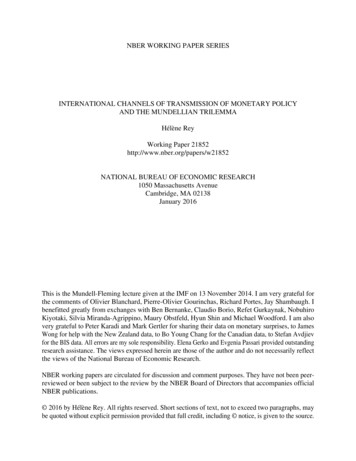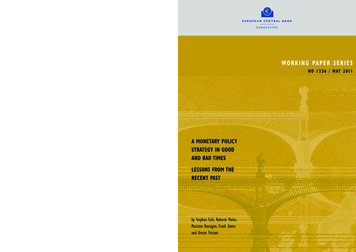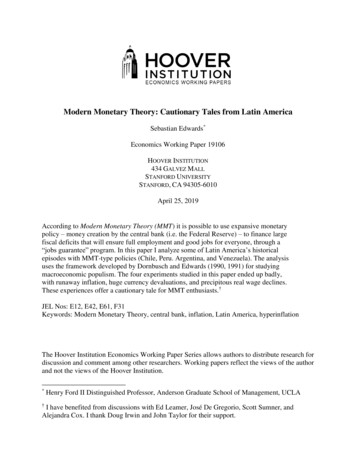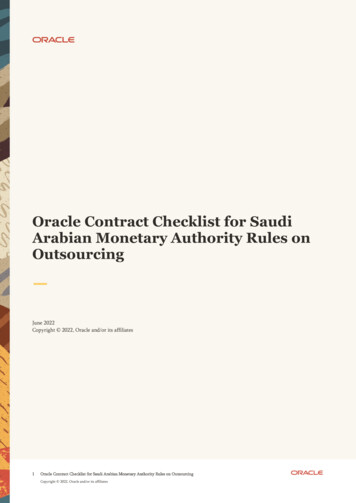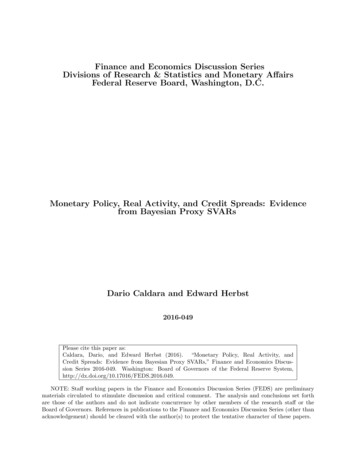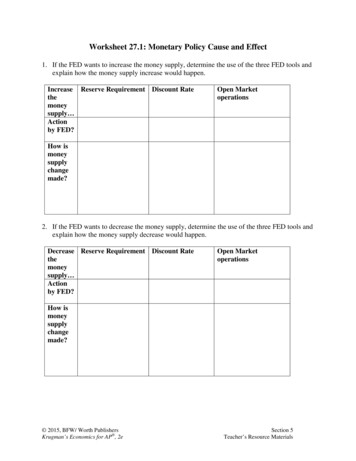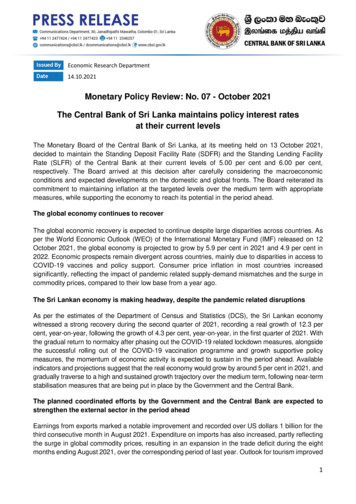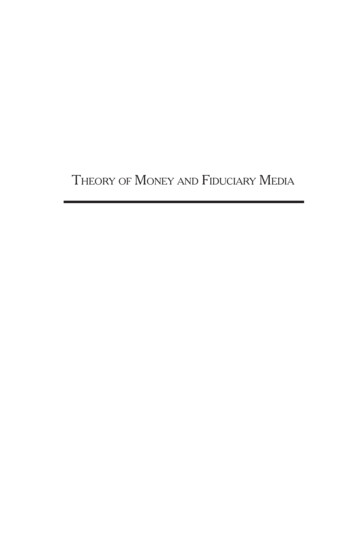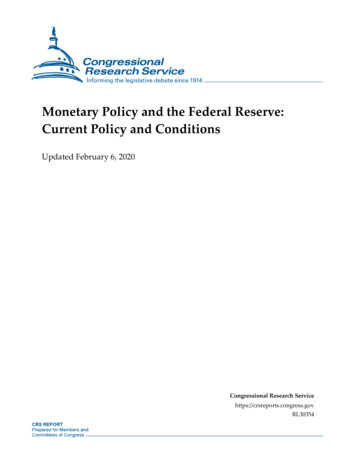
Transcription
Monetary Policy and the Federal Reserve:Current Policy and ConditionsUpdated February 6, 2020Congressional Research Servicehttps://crsreports.congress.govRL30354
SUMMARYMonetary Policy and the Federal Reserve:Current Policy and ConditionsCongress has delegated responsibility for monetary policy to the Federal Reserve (the Fed), thenation’s central bank, but retains oversight responsibilities for ensuring that the Fed is adhering toits statutory mandate of “maximum employment, stable prices, and moderate long-term interestrates.” To meet its price stability mandate, the Fed has set a longer-run goal of 2% inflation.RL30354February 6, 2020Marc LabonteSpecialist inMacroeconomic PolicyThe Fed’s control over monetary policy stems from its exclusive ability to alter the money supplyand credit conditions more broadly. Normally, the Fed conducts monetary policy by setting a target for the federal funds rate,the rate at which banks borrow and lend reserves on an overnight basis. It meets its target through open market operations,financial transactions traditionally involving U.S. Treasury securities. Beginning in 2007, the federal funds target wasreduced from 5.25% to a range of 0% to 0.25% in December 2008, which economists call the zero lower bound. By historicalstandards, rates were kept unusually low for an unusually long time to mitigate the effects of the 2007-2009 financial crisisand its aftermath. Starting in December 2015, the Fed began raising interest rates. In total, the Fed raised rates nine timesbetween 2015 and 2018, by 0.25 percentage points each time. In light of increased economic uncertainty, the Fed thenreduced interest rates by 0.25 percentage points in a series of steps beginning in July 2019.The Fed influences interest rates to affect interest-sensitive spending, such as business capital spending on plant andequipment, household spending on consumer durables, and residential investment. In addition, when interest rates divergebetween countries, it causes capital flows that affect the exchange rate between foreign currencies and the dollar, which inturn affects spending on exports and imports. Through these channels, monetary policy can be used to stimulate or slowaggregate spending in the short run. In the long run, monetary policy mainly affects inflation. A low and stable rate ofinflation promotes price transparency and, thereby, sounder economic decisions.The Fed’s relative independence from Congress and the Administration has been justified by many economists on thegrounds that it reduces political pressure to make monetary policy decisions that are inconsistent with a long-term focus onstable inflation. But independence reduces accountability to Congress and the Administration, and recent criticism of the Fedby the President has raised the question about the proper balance between the two.While the federal funds target was at the zero lower bound, the Fed attempted to provide additional stimulus throughunsterilized purchases of Treasury and mortgage-backed securities (MBS), a practice popularly referred to as quantitativeeasing (QE). Between 2009 and 2014, the Fed undertook three rounds of QE. The third round was completed in October2014, at which point the Fed’s balance sheet was 4.5 trillion—five times its precrisis size. After QE ended, the Fedmaintained the balance sheet at the same level until September 2017, when it began to very gradually reduce it to a morenormal size. The Fed has raised interest rates in the presence of a large balance sheet through the use of two new tools—bypaying banks interest on reserves held at the Fed and by engaging in reverse repurchase agreements (reverse repos) through anew overnight facility. In January 2019, the Fed announced that it would continue using these tools to set interest ratespermanently. In August 2019, it stopped reducing the balance sheet from its current size of 3.8 trillion. However, theremaining MBS on its balance sheet would gradually be replaced with Treasury securities as they mature. In response toturmoil in the repo market in September 2019, the Fed began intervening in the repo market and began expanding its balancesheet again in October 2019.With regard to its mandate, the Fed believes that unemployment is currently lower than the rate that it considers consistentwith maximum employment, and inflation is running slightly below the Fed’s 2% goal by the Fed’s preferred measure.Monetary policy is still considered expansionary, which is unusual at this stage of an expansion, and is being coupled with astimulative fiscal policy (larger structural budget deficit). The decision to cut rates in 2019 was controversial. The Fedjustified the cut on the grounds that risks of a growth slowdown had intensified and inflation was still below 2%. But it alsoargued that the economy was still strong, and some of the risks to the economy, such as higher tariffs, had not yetmaterialized at the time of the decision. Overly stimulative monetary policy in a strong expansion risks economicoverheating, high inflation, or asset bubbles.Congressional Research Service
Monetary Policy and the Federal Reserve: Current Policy and ConditionsContentsIntroduction . 1Recent Monetary Policy Developments . 1How Does the Federal Reserve Execute Monetary Policy? . 4Policy Tools . 4Targeting Interest Rates versus Targeting the Money Supply . 7Real versus Nominal Interest Rates . 7Economic Effects of Monetary Policy in the Short Run and Long Run . 7Low Interest Rates and the Neutral Rate . 9Monetary versus Fiscal Policy . 10Unconventional Monetary Policy and the Fed's Balance Sheet during and after theFinancial Crisis. 12The “Exit Strategy”: Normalization of Monetary Policy after QE. 16The Federal Reserve’s Response to Repo Market Turmoil in September 2019 . 18The Federal Reserve’s Review of Monetary Policy Strategy, Tools, and Communications . 20FiguresFigure 1. Direct Fed Assistance to the Financial Sector . 14TablesTable 1. The Federal Funds Rate at the Peak of Expansions . 2Table 2. Quantitative Easing (QE): Changes in Asset Holdings on the Fed’s BalanceSheet . 14AppendixesAppendix. Regulatory Responsibilities . 22ContactsAuthor Information. 23Congressional Research Service
Monetary Policy and the Federal Reserve: Current Policy and ConditionsIntroductionThe Federal Reserve’s (the Fed’s) responsibilities as the nation’s central bank fall into four maincategories: monetary policy, provision of emergency liquidity through the lender of last resortfunction, supervision of certain types of banks and other financial firms for safety and soundness,and provision of payment system services to financial firms and the government.1Congress has delegated responsibility for monetary policy to the Fed, but retains oversightresponsibilities to ensure that the Fed is adhering to its statutory mandate of “maximumemployment, stable prices, and moderate long-term interest rates.”2 The Fed has defined stableprices as a longer-run goal of 2% inflation—the change in overall prices, as measured by thePersonal Consumption Expenditures (PCE) price index. By contrast, the Fed states that “it wouldnot be appropriate to specify a fixed goal for employment; rather, the Committee’s policydecisions must be informed by assessments of the maximum level of employment, recognizingthat such assessments are necessarily uncertain and subject to revision.”3 Monetary policy can beused to stabilize business cycle fluctuations (alternating periods of economic expansions andrecessions) in the short run, while it mainly affects inflation in the long run. The Fed’sconventional tool for monetary policy is to target the federal funds rate—the overnight, interbanklending rate.4This report provides an overview of how monetary policy works and recent developments, asummary of the Fed’s actions following the financial crisis, and ends with a brief overview of theFed’s regulatory responsibilities.Recent Monetary Policy DevelopmentsIn response to the 2007-2009 financial crisis and the “Great Recession,” the federal funds targetwas reduced to a range of 0% to 0.25% in December 2008—referred to as the zero lowerbound—for the first time ever. The recession ended in 2009, but as the economic recoveryconsistently proved weaker than expected in the years that followed, the Fed repeatedly pushedback its time frame for raising interest rates. As a result, the economic expansion was in itsseventh year and the unemployment rate was already near the Fed’s estimate of full employmentat the time when it began raising rates on December 16, 2015. This was a departure from pastpractice—in the previous two economic expansions, the Fed began raising rates within threeyears of the preceding recession ending. The Fed then raised rates in a series of steps toincrementally tighten monetary policy. The Fed raised rates—by 0.25 percentage points eachtime—once in 2016, three times in 2017, and four times in 2018.In 2019, the expansion became the longest in U.S. history. Beginning in July 2019, the Fedreduced the federal funds target in a series of steps, by 0.25 percentage points at a time. Usually,when the Fed begins cutting interest rates, it subsequently makes several reductions over a series1For background on the makeup of the Federal Reserve, see CRS In Focus IF10054, Introduction to FinancialServices: The Federal Reserve, by Marc Labonte.2 Section 2A of the Federal Reserve Act, 12 U.S.C. §225a.3 Federal Reserve, Statement on Longer-Run Goals and Monetary Policy Strategy, January 24, 2012, es/FOMC LongerRunGoals.pdf.4 Current and past monetary policy announcements can be accessed at alendars.htm. For more information on the business cycle, see CRS In Focus IF10411, Introduction to U.S.Economy: The Business Cycle and Growth, by Jeffrey M. Stupak.Congressional Research Service1
Monetary Policy and the Federal Reserve: Current Policy and Conditionsof months in response to the onset of a recession, although sometimes the rate cuts are moremodest and short-lived “mid-cycle corrections.”5 If the range of 2.25%-2.5% turns out to be thehighest that the federal funds target reached in the current expansion, then it will have been muchlower than at the peak of previous expansions in either nominal or inflation-adjusted terms, asshown in Table 1.Table 1. The Federal Funds Rate at the Peak of Expansions1957-2019Date of Peak RatePeak Rate (Nominal)Peak Rate (InflationAdjusted)CumulativeSubsequent Reductionin Nominal Rate(Percentage Points)October 19573.5%0.6%2.9February 19604.0%2.6%2.8September 19699.2%3.5%5.5July 197412.9%1.4%7.7April 198017.6%3.0%4.8June 198119.1%9.4%10.4May 19899.8%4.5%5.3November 20006.5%3.1%4.8July 20075.3%2.9%5.1As of July 20192.4%0.6%potential max of 2.4Sources: CRS calculations based on Fed data; David Reifschneider, “Gauging the Ability of the FOMC toRespond to Future Recessions,” Federal Reserve, Finance and Economics Discussion Series 2016-068, August 2016.Notes: Federal funds rate adjusted for inflation using the consumption price index. In early expansions in thetable, the federal funds rate was not the explicit target of monetary policy. The table presents the averageeffective federal funds rate.The rate cuts seem to have been in response to a slowdown in growth. After being persistentlylow by historical standards throughout the expansion, economic growth accelerated from the thirdquarter of 2017 through the third quarter of 2018. Since the fourth quarter of 2018, economicgrowth appears to have slowed from this elevated pace back toward the previous trend, whereprojections expect it to stay in the coming quarters.6The Fed’s decision to reduce rates can be evaluated in terms of its statutory mandate. Based onthe maximum employment mandate, tight labor market conditions did not support the series ofrate cuts, considering monetary policy was still slightly stimulative—adjusted for inflation, rateswere close to zero even before they were cut. The unemployment rate has been below 5% since2015 and is now lower than the rate believed to be consistent with full employment. Other labormarket indicators are also consistent with full employment, with the possible exception of thestill-low labor force participation rate.Based on the price stability mandate, lower rates could be justified to avoid a potentially longlasting decline in inflation (which would be unexpected, given labor market tightness). After5See CRS Insight IN11152, Why Is the Federal Reserve Reducing Interest Rates?, by Marc Labonte.For more information, see CRS Report R46200, Recent Slower Economic Growth in the United States: PolicyImplications, by Marc Labonte.6Congressional Research Service2
Monetary Policy and the Federal Reserve: Current Policy and Conditionsremaining persistently below the Fed’s 2% target from mid-2012 to early 2018 as measured bycore PCE, inflation hovered around 2% in 2018 as measured by headline or core PCE. Inflationthen dipped slightly below 2% again in 2019. Economic theory posits that lower unemploymentwill lead to higher inflation in the short run, but inflation has not proven responsive to lowerunemployment in recent years.7 Arguably, the experiences of Japan since the 1990s and the euroarea since the financial crisis demonstrate that persistently lower-than-desirable inflation hasbecome a harder problem than high inflation for central banks to solve.Monetary policy works with a lag, and if economic conditions were to deteriorate in the nearfuture, it would be helpful to have cut rates ahead of time. Financial volatility has increased, andthe Fed has argued that there are heightened risks to the economic outlook coming from theslowdown in growth abroad and the potential for economic disruptions from “trade policyuncertainty.”8 (Distinct from monetary stimulus, the Fed has intervened in repo markets sinceSeptember 2019 in response to repo market volatility. For more information, see the sectionbelow entitled “The Federal Reserve’s Response to Repo Market Turmoil in September 2019.”)Although it believes the most likely scenario is sustained expansion, the Fed has justified the2019 rate cuts in risk-management terms as “insurance cuts.” But cutting rates also poses risks.9The Fed has little headroom to lower rates more aggressively during the next economicdownturn—the potential two-percentage-point reduction in rates remaining before hitting the zerobound is currently smaller than the rate cuts that the Fed has undertaken in past recessions, asshown in the right hand column of Table 1.10 Fed Chair Jerome Powell and other Fed officialshave argued that, with limited headroom, it is better to cut rates aggressively when risks rise tonip a potential downturn in the bud.11 The counterargument is that when your arsenal is limited, itis better to keep your powder dry until you are sure it is needed. By cutting rates in 2019, the Fedleaves itself less scope for monetary stimulus in the future.There is upside risk to cutting rates as well. If downside risks to the outlook do not materialize(for example, if a trade war is averted), monetary stimulus could cause the economy to overheat,resulting in high inflation and posing risk to financial stability. The Fed has signaled it intends tokeep interest rates at their current level for now, even though some of these downside risks seemto be diminishing. As an example of how overly stimulative monetary policy can lead to financialinstability, critics contend that the Fed contributed to the precrisis housing bubble by keepinginterest rates too low for too long during the economic recovery starting in 2001. Critics see theserisks as outweighing any marginal benefit associated with monetary stimulus when the economyis already so close to full employment.12 Finally, there is reputational risk to the Fed’sindependence if it appears that the Fed is cutting rates in response to political pressure from thePresident (see the text box “Federal Reserve Independence” below).7For more information, see CRS Report R44663, Unemployment and Inflation: Implications for Policymaking, byMarc Labonte.8 See CRS Insight IN10971, Escalating U.S. Tariffs: Affected Trade, coordinated by Brock R. Williams.9 Federal Reserve, “Transcript of Chairman Powell’s Press Conference,” July 31, 2019, /FOMCpresconf20190731.pdf.10 Janet Yellen, “The Federal Reserve’s Monetary Policy Toolkit,” speech at Jackson Hole, WY, August 26, 2016, /yellen20160826a.htm.11 Nick Timiraos, “Powell Says Fed Won’t Bend to Political Pressure,” Wall Street Journal, June 25, 2019, -cuts11561481986.12 See, for example, John Taylor, “A Monetary Policy for the Future,” speech at the International Monetary Fund, April15, 2015, at http://web.stanford.edu/ johntayl/2015 pdfs/A Monetary Policy For the Future-4-15-15.pdf.Congressional Research Service3
Monetary Policy and the Federal Reserve: Current Policy and ConditionsHow Does the Federal Reserve ExecuteMonetary Policy?Monetary policy refers to the actions the Fed undertakes to influence the availability and cost ofmoney and credit to promote the goals mandated by Congress, a stable price level and maximumsustainable employment. Because the expectations of households as consumers and businesses aspurchasers of capital goods exert an important influence on the major portion of spending in theUnited States, and because these expectations are influenced in important ways by the Fed’sactions, a broader definition of monetary policy would include the directives, policies, statements,economic forecasts, and other Fed actions, especially those made by or associated with thechairman of its Board of Governors, who is the nation’s central banker.The Fed’s Federal Open Market Committee (FOMC) meets every six weeks to choose a federalfunds target and sometimes meets on an ad hoc basis if it wants to change the target betweenregularly scheduled meetings. The FOMC is composed of the 7 Fed governors, the President ofthe Federal Reserve Bank of New York, and 4 of the other 11 regional Federal Reserve Bankpresidents serving on a rotating basis.13The Fed generally tries to avoid policy surprises, and FOMC members regularly communicatetheir views on the future direction of monetary policy to the public. The Fed describes itsmonetary policy plans as “data dependent,” meaning they would be altered if actual employmentor inflation deviate from its forecast.Policy ToolsThe Fed targets the federal funds rate to carry out monetary policy. The federal funds rate isdetermined in the private market for overnight reserves of depository institutions (called thefederal funds market). At the end of a given period, usually a day, depository institutions mustcalculate how many dollars of reserves they want or need to hold against their reservableliabilities (deposits).14 Some institutions may discover a reserve shortage (too few reservableassets relative to those they want to hold), whereas others may have reservable assets in excess oftheir wants. These reserves can be borrowed and lent on an overnight basis in a private marketcalled the federal funds market. The interest rate in this market is called the federal funds rate. Ifit wishes to expand money and credit, the Fed will lower the target, which encourages morelending activity and, thus, greater demand in the economy. Conversely, if it wishes to tightenmoney and credit, the Fed will raise the target.The federal funds rate is linked to the interest rates that banks and other financial institutionscharge for loans. Thus, whereas the Fed may directly influence only a very short-term interestrate, this rate influences other longer-term rates. However, this relationship is far from being on aone-to-one basis because longer-term market rates are influenced not only by what the Fed is13Of the monetary policy tools described below, the board is generally responsible for setting reserve requirements andinterest rates paid by the Fed, whereas the federal funds target is set by the FOMC. The discount rate is set by the 12Federal Reserve banks, subject to the board’s approval. In practice, the board and FOMC coordinate the use of thesetools to implement a consistent monetary policy stance. The New York Fed determines what open market operationsare necessary on an ongoing basis to maintain the federal funds target.14 Depository institutions are obligated by law to hold some fraction of their deposit liabilities as reserves. They are alsolikely to hold additional or excess reserves based on certain risk assessments they make about their portfolios andliabilities.Congressional Research Service4
Monetary Policy and the Federal Reserve: Current Policy and Conditionsdoing today, but also by what it is expected to do in the future and by what inflation is expected tobe in the future. This fact highlights the importance of expectations in explaining market interestrates. For that reason, a growing body of literature urges the Fed to be very transparent inexplaining what its policy is, will be, and in making a commitment to adhere to that policy.15 TheFed has responded to this literature and is increasingly transparent in explaining its policymeasures and what these measures are expected to accomplish.The Federal Reserve uses two methods to maintain its target for the federal funds rate: Traditionally, the Fed primarily relied on open market operations, which involvesthe Fed buying existing U.S. Treasury securities in the secondary market (i.e.,those that have already been issued and sold to private investors).16 Should theFed buy securities, it does so with the equivalent of newly issued currency(Federal Reserve notes), which expands the reserve base and increases the abilityof depository institutions to make loans and expand money and credit. Thereverse is true if the Fed decides to sell securities from its portfolio. The Fedmust stand ready to buy or sell as many securities as necessary to maintain itsfederal funds target. Outright purchases of securities were used for QE from 2009to 2014, but normal open market operations are typically conducted throughrepos instead, described in the text box. When the Fed wishes to add liquidity tothe banking system, it enters into repos. When it wishes to remove liquidity, theFed enters into reverse repos.17 Because of the large increase in bank reservescaused by QE, open market operations alone can no longer effectively maintainthe federal funds target.What Are Repos?Repurchase agreements (repos) are agreements between two parties to purchase and then repurchase securitiesat a fixed price and future date, often overnight. Although legally structured as a pair of security sales, they areeconomically equivalent to a collateralized loan. The difference in price between the first and second transactiondetermines the interest rate on the loan. The repo market is one of the largest short-term lending markets, wherebanks and other financial institutions are active borrowers and lenders. For the seller of the security, who receivesthe cash, the transaction is called a repo. For the purchaser of the security, who lends the cash, it is called areverse repo. (When describing transactions, the Fed uses the terminology from the perspective of itscounterparty.) Collateral protects the lender against potential default. In principle, any type of security can be usedas collateral, but the most common collateral—and the types used by the Fed—are Treasury securities, agencyMBS, and agency debt.Note: For background on the repo market, see CRS In Focus IF11383, Repurchase Agreements (Repos): A Primer, byMarc Labonte; and Tobias Adrian et al., “Repo and Securities Lending,” Federal Reserve Bank of New York, StaffReport no. 529, December 2011, available at http://www.newyorkfed.org/research/staff reports/sr529.pdf.See, for example, Anthony M. Santomero, “Great Expectations: The Role of Beliefs in Economics and MonetaryPolicy,” Business Review, Federal Reserve Bank of Philadelphia, Second Quarter 2004, pp. 1-6, and Gordon H. Sellon,Jr., “Expectations and the Monetary Policy Transmission Mechanism,” Economic Review, Federal Reserve Bank ofKansas City, Fourth Quarter 2004, pp. 4-42.16 The Fed is legally forbidden from buying securities directly from the Department of the Treasury. Instead, it buysthem on secondary markets from primary dealers. For a technical explanation of how open market operations areconducted, see Cheryl L. Edwards, “Open Market Operations in the 1990s,” Federal Reserve Bulletin, November 1997,pp. 859-872; and Benjamin Friedman and Kenneth Kuttner, Implementation of Monetary Policy: How Do CentralBanks Set Interest Rates?, National Bureau of Economic Research, Working Paper no. 16165, March 2011.17 In addition to open market operations, the Fed has entered into reverse repos since 2013 through a newly createdfacility, the Overnight Reverse Repurchase Operations Facility. See the section below entitled “The “Exit Strategy”:Normalization of Monetary Policy after QE.”15Congressional Research Service5
Monetary Policy and the Federal Reserve: Current Policy and Conditions The Fed can also change the two interest rates it administers directly by fiat, andthese interest rates influence market rates—the rate it charges to borrowers andthe rate it pays to depositors. The Fed permits depository institutions to borrow from it directly on atemporary basis at the discount window.18 That is, these institutions candiscount at the Fed some of their own assets to provide a temporary meansfor obtaining reserves. Discounts are usually on an overnight basis. For thisprivilege banks are charged an interest rate called the discount rate, which isset by the Fed at a small markup over the federal funds rate.19 The Fed isreferred to as the “lender of last resort” because direct lending, from thediscount window and other recently created lending facilities, is negligibleunder normal financial conditions such as the present but was an importantsource of liquidity during the financial crisis.In October 2008, the Federal Reserve began to pay interest on reserves thatbanks deposit at the Fed. (It pays interest on both required and excessreserves.) Since 2008, this has been the primary tool for maintaining thefederal funds target. Reducing the opportunity cost for banks of holding thatmoney as reserves at the Fed as opposed to lending it out influences the ratesat which banks are willing to lend reserves to each other, such as the federalfunds rate.Since the financial crisis, interest on reserves has been the primary tool for influencing the federalfunds rate. However, the Fed has also used reverse repos and began using repos again after repomarket turmoil in September 2019 (see the section below entitled “The Federal Reserve’sResponse to Repo Market Turmoil in September 2019”).The Fed can also change the federal funds rate by changing reserve requirements, which specifywhat portion of customer deposits (primarily checking accounts) banks must hold as vault cash oron deposit at the Fed. Thus, reserve requirements affect the liquidity available within the federalfunds market. Statute sets the numerical levels of reserve requirements, although the Fed hassome discretion to adjust them. Currently, banks are required to hold 0% to 10% of customerdeposits that qualify as net transaction accounts in reserves, depending on the size of the bank’sdeposits.20 This tool is used rarely—the percentage was last changed in 1992.21Each of these tools works by altering the overall liquidity available for use by the bankingsystem, which influences the amount of assets these institutions can acquire. These assets areoften called credit because they represent loans the institutions have made to businesses andhouseholds, among others.18All depository institutions, as defined by 12 U.S.C. §461, may borrow from the discount window and are subject toreserve requirements regardless of whether they are members of the Federal Reserve.19 Until 2003, the discount rate was set slightly below the federal funds target, and the Fed used moral suasion todiscourage healthy banks from profiting from this low rate. To reduce the need for moral suasion, lending rules werealtered in early 2003. Since that time, the discount rate has
The Fed's control over monetary policy stems from its exclusive ability to alter the money supply and credit conditions more broadly. Normally, the Fed conducts monetary policy by setting a target for the federal funds rate, the rate at which banks borrow and lend reserves on an overnight basis. It meets its target through open market operations,


